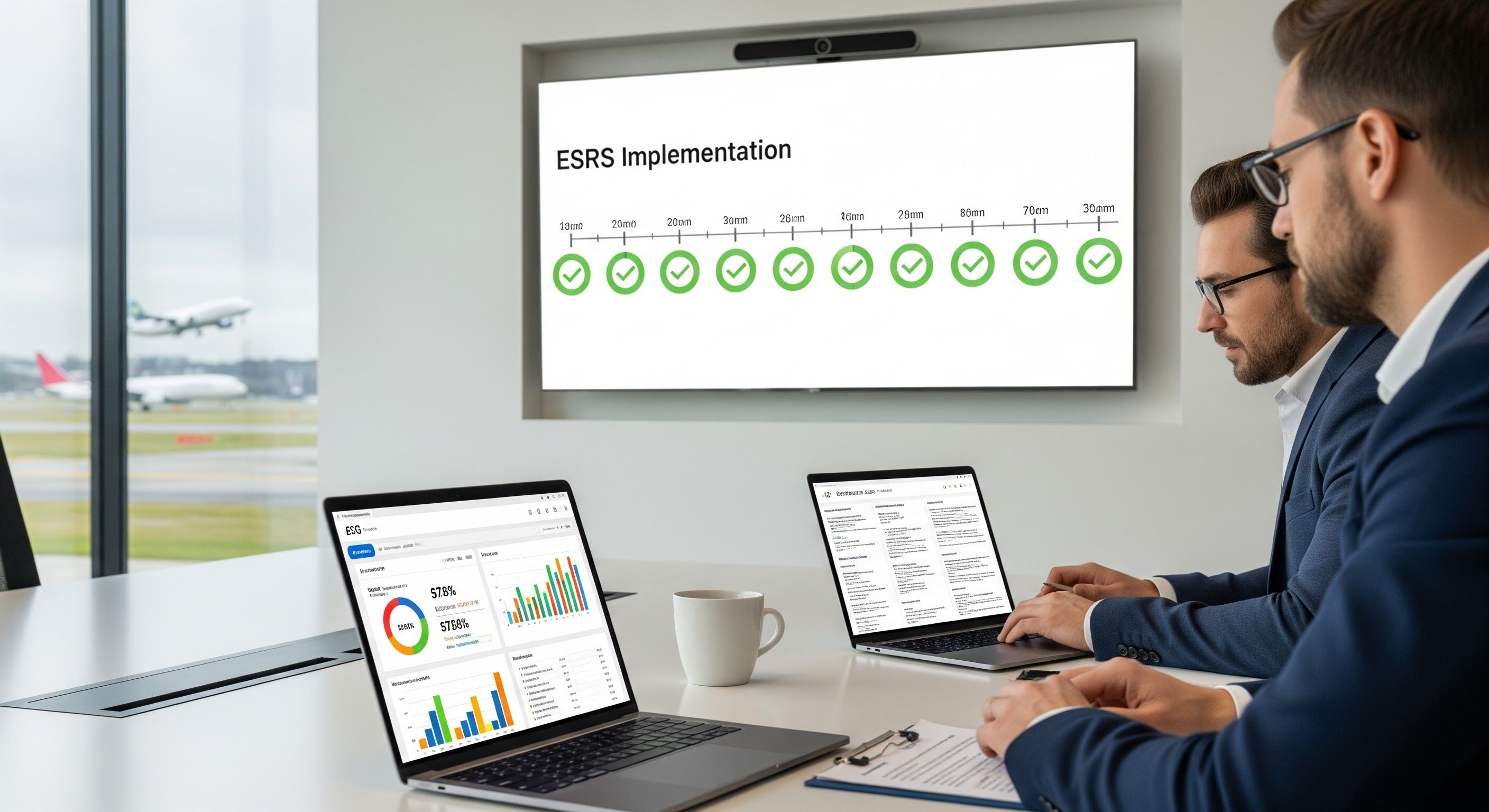
Sustainable Travel
Definition and impact of ESRS for aviation professionals
Published Friday, September 19, 2025
The European Sustainability Reporting Standards (ESRS) are set to transform how aviation companies disclose environmental, social and governance (ESG) information. As the aviation industry faces increasing pressure to reduce its climate impact and improve sustainability, understanding and implementing ESRS will be critical for compliance and competitiveness. This article provides an essential guide for aviation professionals on the key objectives, requirements and practical steps for adopting ESRS in their operations. By aligning with these standards, aviation companies can enhance transparency, mitigate risks and position themselves as leaders in sustainable aviation.
- Definition and impact of ESRS for aviation professionals
- Implementing ESRS in aviation operations
- ESRS requirements for aviation
1- Definition and impact of ESRS for aviation professionals
Training and organisational changes
Controlled spreadsheets can work initially, but specialised platforms help with data capture, validation, calculation engines, digital tagging/XBRL, and generation of ESRS-aligned outputs (including per-flight certificates and client-level consolidations) that plug into corporate clients’ workflows.
Reporting tools and technologies
Start with existing operational data—fuel uplift records, flight logs, supplier documentation (including SAF chain-of-custody), and, where available, EU-ETS/MRV datasets. ESRS/CSRD does not require installing new onboard sensors. Use methods consistent with ESRS E1 and the GHG Protocol, disclose factors/assumptions, and document estimation methods to close gaps. Maintain a robust audit trail (sources, timestamps, approvals) to support limited assurance.
2- Implementing ESRS in aviation operations
Companies disclose material information on workforce (e.g., H&S, D&I, labour practices), affected communities, consumers, and governance (roles, oversight, risk management, business conduct). If executive pay is linked to sustainability, it should be described—there is no obligation to link pay to ESG outcomes.
Social and governance factors
Beyond climate, ESRS requires disclosures on other environmental topics where material (e.g., pollution, water, biodiversity, resource use and circular economy). Non-CO₂ aviation effects (e.g., NOx, contrails) may be discussed as contextual KPIs if material, but are not prescribed metrics in ESRS today.
- Any SAF (book-and-claim) and carbon credits/removals must be disclosed separately and do not reduce the reported gross Scope 1–3 figures.
- Per-flight or per-passenger indicators can be offered as optional KPIs to meet client expectations, but they are not mandated by ESRS.
- Scope 3 Category 6 (Business travel) concerns the reporting company’s own employees travelling; emissions from transporting customers/clients are reported by those customers in their own inventories.
- For airlines and business-aviation operators, Scope 1 (direct fuel combustion) is typically the dominant category.
Where climate is material, companies disclose gross Scope 1, Scope 2 and Scope 3 emissions under ESRS E1, plus a GHG intensity metric (total GHG per net revenue).
3- ESRS requirements for aviation
- Listed SMEs (except micro): first reports in 2029 on FY2028. This is subject to adoption/transposition at Member-State level. There is no CSRD/ESRS timetable by aircraft weight (MTOM)—that belongs to ETS/MRV/CORSIA, not ESRS.
- Other large undertakings: first reports in 2028 on FY2027.
- Ex-NFRD entities: report in 2025 on FY2024 (unchanged).
Following the EU’s 2025 “stop-the-clock” adjustments, the phase-in is:
Timeline for implementation
ESRS implements the Corporate Sustainability Reporting Directive (CSRD) and complements the EU’s sustainable finance architecture (e.g., EU Taxonomy). It is designed to be interoperable with international frameworks (e.g., GRI; and with IFRS/ISSB concepts), but ESRS is the binding EU standard—not an exact equivalence with other frameworks.
Regulatory framework
Sustainability reporting has long suffered from inconsistent frameworks and metrics. ESRS aims to fix this by providing a harmonised, mandatory set of standards that improve consistency, reliability and comparability. ESRS also brings sustainability reporting onto a footing closer to financial reporting, requiring material ESG disclosures in the management report, supported by governance, controls and limited assurance.
In conclusion, the European Sustainability Reporting Standards (ESRS) represent a significant step forward in enhancing the consistency, reliability and comparability of ESG disclosures in the aviation industry. By providing a standardized framework for reporting environmental, social and governance factors, ESRS will enable aviation companies to meet rising expectations for transparency and accountability. Implementing ESRS will require investment in data collection systems, reporting technologies and employee training. However, by aligning with these new standards, aviation companies can identify opportunities to improve their sustainability performance, mitigate risks and position themselves as leaders in the journey towards net zero.
Book a private flight
With Orizair, discover hundreds of available flights to reach your destination the green way.
Find your destinationAt Orizair, we integrate sustainability into private aviation by automatically offsetting the carbon emissions of every flight and collaborating with committed partners like Treesition. Discover our commitment.